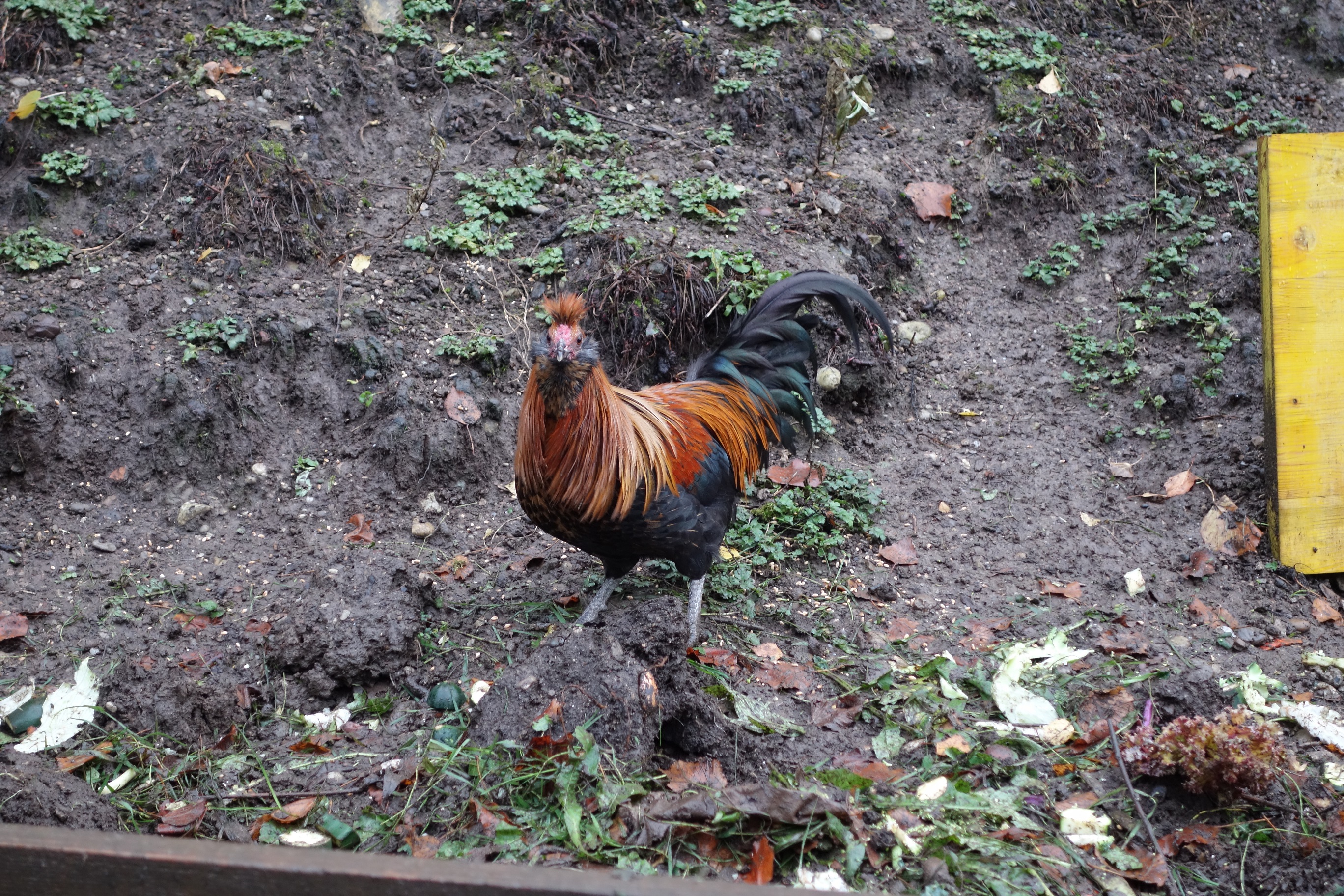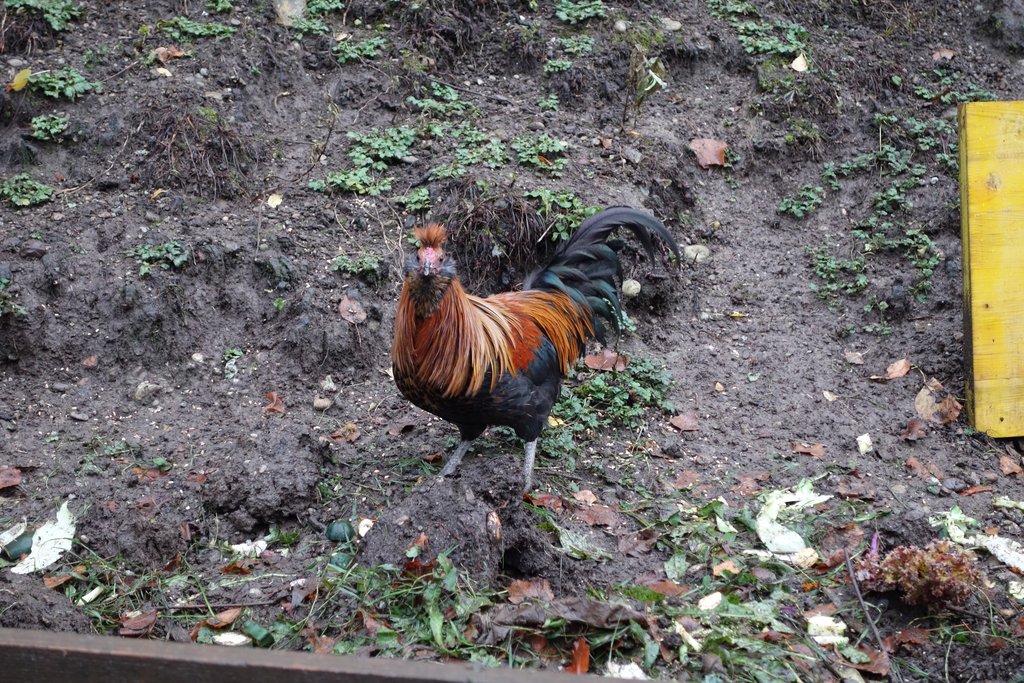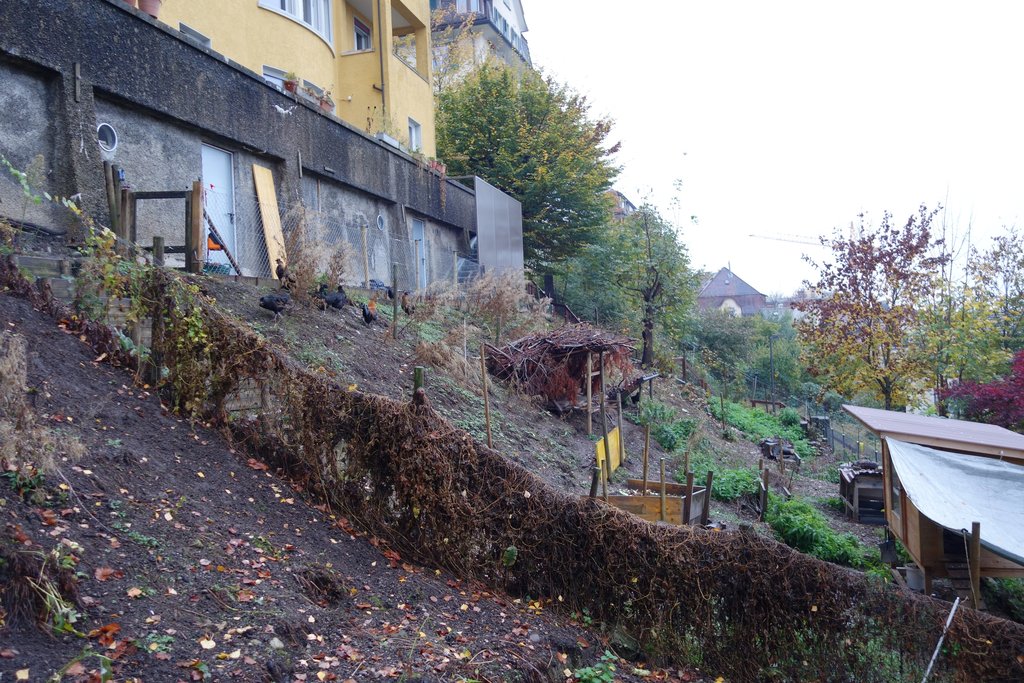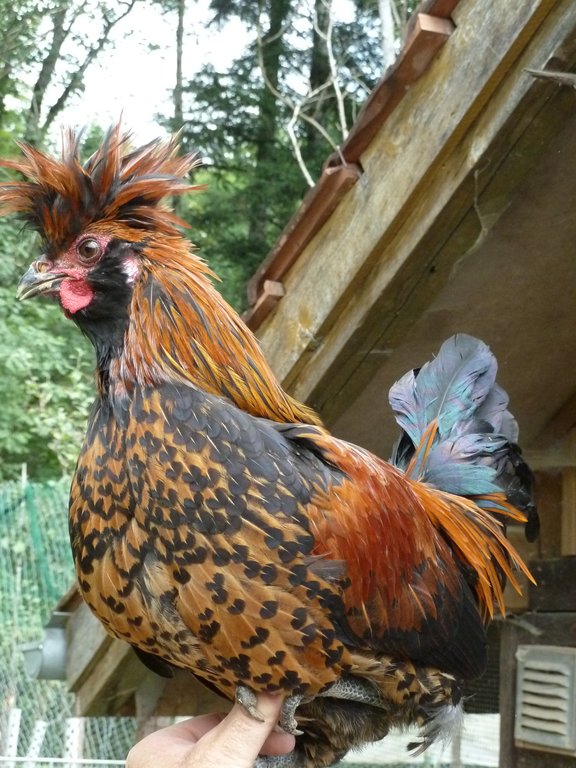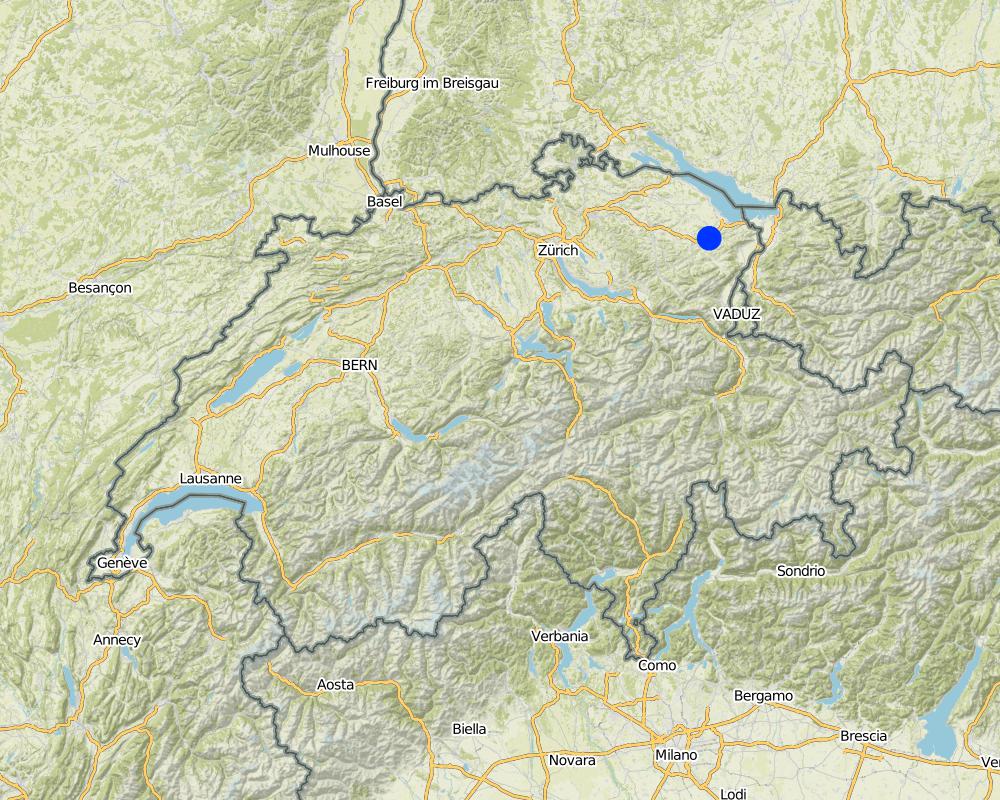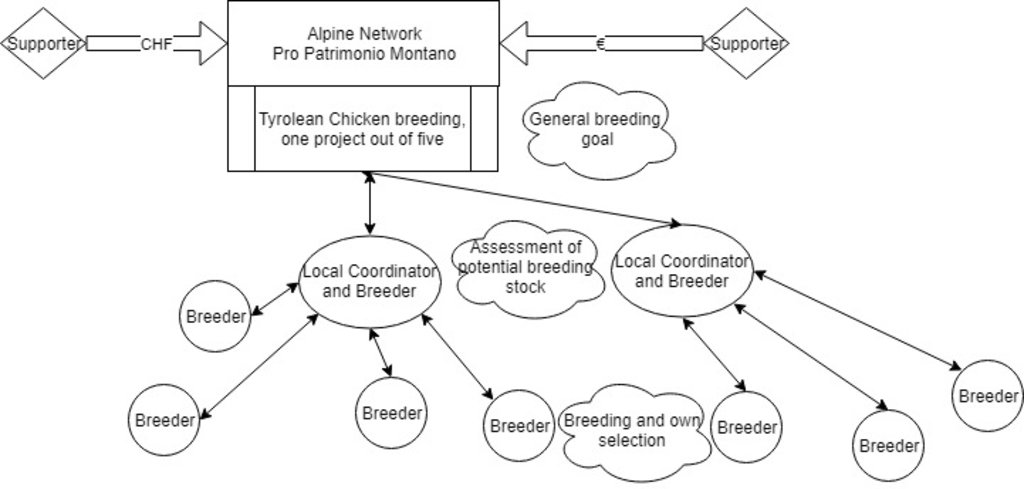Organisation of the breeding for the new Tyrolean Chicken [Suisse]
- Création :
- Mise à jour :
- Compilateur : Stefan Graf
- Rédacteur : –
- Examinateur : Alexandra Gavilano
Zuchtgruppenorganisation für das Neu-Tirolerhuhn
approaches_4165 - Suisse
Voir les sections
Développer tout Réduire tout1. Informations générales
1.2 Coordonnées des personnes-ressources et des institutions impliquées dans l'évaluation et la documentation de l'Approche
Personne(s) ressource(s) clé(s)
Spécialiste GDT:
Grünenfelder Hans-Peter
www.patrimont.org
Pro Patrimonio Montano
www.patrimont.org
Suisse
exploitant des terres:
Waibel Benjamin
Suisse
Nom du ou des institutions qui ont facilité la documentation/ l'évaluation de l'Approche (si pertinent)
Bern University of Applied Sciences, School of Agricultural, Forest and Food Sciences (HAFL) - Suisse1.3 Conditions relatives à l'utilisation par WOCAT des données documentées
Quand les données ont-elles été compilées (sur le terrain)?
29/10/2018
Le compilateur et la(les) personne(s) ressource(s) acceptent les conditions relatives à l'utilisation par WOCAT des données documentées:
Oui
2. Description de l'Approche de GDT
2.1 Courte description de l'Approche
A new chicken breed is developed based on three remnants populations having similar looks, with the purpose of recreating a healthy chicken adapted to mounaneous areas.
2.2 Description détaillée de l'Approche
Description détaillée de l'Approche:
Chicken with a crest have been known in the alpine areas of Switzerland, Austria and Italy for many centuries, as bone excavations, historic paintings and old pictures show. Crested chicken can still be found in Switzerland, now called “Appenzeller Spitzhauben, and in north-eastern Italy, as Polverara. Members of the association Pro Patrimonio Montano supposed that these chickens are the southeastern and western remnants of the same population of chicken and wondered what would happen if they crossed the two breeds. In 2010 crosses were done in both ways. As the crossed individuals all turned out black, and quite uniform, the initiators decided to start a serious breeding project with the aim of developing a breed adapted to the alpine conditions while relying only on the genetics of the two former chicken breeds. Later a small population of crested chicken, supposed to be other remnants of the Tyrolean chicken, was found on a remote farm in a remote valley, the Sarntal, and integrated into the breeding project of the “New Tyrolean Chicken”. The roosters of descendants of the Sarntal chicken are quite aggressive, reason why it is not used extensively in the new Tyrolean chicken breed.
The breeding is decentralized, with many small-scale farmers, hobby chicken keepers, and other interested persons keeping breeding groups. The breeders are organized in regional groups, with one regional coordinator overseeing 3 to 7 chicken breeders. The regional coordinator is assessing each newly hatched chicken and rooster to select for the ones being kept for further breeding. Selection takes place for morphological traits to match the ancient type of Tyrolean chicken. The selection for this ancient phenotype is due to the fact that the appenzeller Spitzhauben” has been crossed with other chicken because of concern with inbreeding, as the population was based only on a few individuals.
The regional coordinator is compensated for each chicken he or she assesses with 3 CHF/€, and additionally 2 CHF/€ per ring put on a chicken suitable for breeding. The assessment takes place at around 13 weeks. The assessment is then sent on an excel file to the coordinator at Pro Patrimonio Montano, where all files are added together. Each chicken has its ancestors recorded, with the maternal line being merged as sisters bred together.
Pro Patrimonio Montano is organized as an association, overseeing currently five breed and species of animals. The voting inside the organization for changing rules is done by representants of the breeders. Each region with up to 50 breeders has one voice at votes, can therefore send one representative. Regions with more than 50 breeders have two votes, thus two representatives.
2.3 Photos de l'approche
2.5 Pays/ région/ lieux où l'Approche a été appliquée
Pays:
Suisse
Région/ Etat/ Province:
As well as Italy and Austria
Map
×2.6 Dates de début et de fin de l'Approche
Indiquez l'année de démarrage:
2010
2.7 Type d'Approche
- initiative/ innovation récente locale
2.8 Principaux objectifs de l'Approche
The objective is to breed a healthy chicken for the alpine region, while keeping the old remaining genetics of crested alpine chicken.
2.9 Conditions favorisant ou entravant la mise en œuvre de la(des) Technologie(s) appliquée(s) sous l'Approche
normes et valeurs sociales/ culturelles/ religieuses
- favorise
The keeping of ancient breeds starts to be culturally promoted
collaboration/ coordination des acteurs
- favorise
The fact that different regions have coordinators helps to implement sustainable ways to keep chicken.
cadre politique
- entrave
As it is a project working over three countries, the legal framework is different in each country. The exchange of bloodlines is also hindered due to this.
connaissances sur la GDT, accès aux supports techniques
- favorise
The more is known about chicken keeping, the better they can be kept.
marchés (pour acheter les intrants, vendre les produits) et prix
- entrave
The chicken Tyrolean chicken cannot compete with the hybrids, even if it lays well compared to other ancient breeds. It is more useful in a smaller setting than on an industrial scale.
3. Participation et rôles des parties prenantes impliquées dans l'Approche
3.1 Parties prenantes impliquées dans l'Approche et rôles
- exploitants locaux des terres / communautés locales
Hobby chicken keepers as well as small scale farmers
They breed the chicken, and some breeders are regional coordinators. The regional coordinators assess the new animals to see if they can be kept as breeders or removed from the gene pool.
- ONG
The breeding takes place under the umbrella of the NGO Pro Patrimonio Montano, who is currently overseeing five alpine animal breeds.
Provides the legal framework as an association.
3.2 Participation des exploitants locaux des terres/ communautés locales aux différentes phases de l'Approche
| Participation des exploitants locaux des terres/ communautés locales | Spécifiez qui était impliqué et décrivez les activités | |
|---|---|---|
| initiation/ motivation | auto-mobilisation | Two breeders, one of polverara chicken, the other of Appenzeller spitzhauben, decided to see what would happen if the two breeds were crossed. Out of this, the project started. |
| planification | interactive | The initiators, being only two, found others with which they could breed the new Tyrolean chicken. |
| mise en œuvre | interactive | As two breeders on a small scale are not enough, others joined. |
| suivi/ évaluation | interactive | The egg laying is monitored only by a few chicken keepers. An evaluation of the breeding stock takes place for every animal about to enter the gene pool. |
3.3 Diagramme/ organigramme (si disponible)
Description:
Pro Patrimonio Montano (Patrimont) is the association under which the breeding of the New Tyrolean Chicken takes place. Patrimont is financed by supporters, and is a tax-deductible association in Switzerland.
Patrimont decided on a general phenotype (breeding goal) for the new tyrolean chicken. It does not recognize animals which are outcrossed for a better look or color, as it wants to keep the genetics of the alpine crested chicken.
The breeders, who can be farmers, hobby keepers, or other (zoo...) breed the chicken which are then assessed by a regional coordinator. If they meet the requirements of Patrimont, the breeder can use them for further breeding. Usually, the hens are kept, and the roosters are exchanged or sold. The regional coordinator keep a record on the ancestry of each chick hatched, and coordinate exchange of roosters, even among regional groups.
Auteur:
Stefan Graf
3.4 Prises de décision pour la sélection de la Technologie/ des Technologies
Indiquez qui a décidé de la sélection de la Technologie/ des Technologies à mettre en œuvre:
- principalement les exploitants des terres soutenus par des spécialistes de la GDT
Expliquez:
All the chicken keepers chose to breed or not. Regional coordinators help with the selection of the breeding stock.
Spécifiez sur quelle base ont été prises les décisions:
- l'évaluation de connaissances bien documentées en matière de GDT (prises de décision fondées sur des preuves tangibles)?
- expériences et opinions personnelles (non documentées)
4. Soutien technique, renforcement des capacités et gestion des connaissances
4.1 Renforcement des capacités/ formation
Une formation a-t-elle été dispensée aux exploitants des terres/ autres parties prenantes?
Oui
Spécifiez qui a été formé:
- personnels/ conseillers de terrain
Formats de la formation:
- sur le tas
- cours
Thèmes abordés:
Selection of the breeding stock. The training is only for the regional coordinators.
4.2 Service de conseils
Les exploitants des terres ont-ils accès à un service de conseils?
Oui
Spécifiez si le service de conseils est fourni:
- dans les champs des exploitants?
Décrivez/ commentez:
The advisory service is given by the regional coordinators.
4.3 Renforcement des institutions (développement organisationnel)
Des institutions ont elles été mises en place ou renforcées par le biais de l'Approche?
- oui, modérément
Spécifiez à quel(s) niveau(x), ces institutions ont été renforcées ou mises en place:
- régional
Décrivez l'institution, ses rôles et responsabilités, ses membres, etc.
The regional coordinators were put in place to coordinate the breeding and to advise the chicken keepers.
Précisez le type de soutien:
- renforcement des capacités/ formation
4.4 Suivi et évaluation
Le suivi et l'évaluation font ils partie de l'Approche? :
Oui
Commentaires:
A monitoring and evaluation of the breeding stock only takes place before the onset of the laying. The egg production is only evaluated by a few chicken keepers.
Si oui, ce document est-il destiné à être utilisé pour le suivi et l'évaluation?
Non
4.5 Recherche
La recherche a-t-elle fait partie intégrante de l’Approche?
Oui
Donnez plus de détails et indiquez qui a mené ces recherches:
The project started as an experiment to research what would happen if the Polverara and the Appenzeller Spitzhauben chicken were crossed.
5. Financement et soutien matériel externe
5.1 Budget annuel de la composante GDT de l'Approche
Si le budget annuel précis n'est pas connu, indiquez une fourchette:
- < 2 000
Commentez (par ex. principales sources de financement/ principaux bailleurs de fonds):
Mainly donations via the association Pro Patrimonio Montano.
In the early years of the project, the budget was higher due to the necessary animal transports.
5.2 Soutiens financiers/ matériels fournis aux exploitants des terres
Les exploitants des terres ont-ils reçu un soutien financier/ matériel pour la mise en œuvre de la Technologie/ des Technologies?
Non
5.3 Subventions pour des intrants spécifiques (incluant la main d'œuvre)
- autre
| Autre (spécifiez) | Dans quelle mesure | Spécifiez les subventions |
|---|---|---|
| Breeding stock | entièrement financé | In the beginning of the project, chicken were given free of charge to the keepers, with the condition that they had to give back breeding stock. |
5.4 Crédits
Des crédits ont-ils été alloués à travers l'Approche pour les activités de GDT?
Non
5.5 Autres incitations ou instruments
D'autres incitations ou instruments ont-ils été utilisés pour promouvoir la mise en œuvre des Technologies de GDT?
Non
6. Analyses d'impact et conclusions
6.1 Impacts de l'Approche
Est-ce que l'Approche a mobilisé/ amélioré l'accès aux ressources financières pour la mise en œuvre de la GDT?
- Non
- Oui, un peu
- Oui, modérément
- Oui, beaucoup
As there is an association behind the breeding of the tyrolean chicken, the regional coordinators get a small compensation for the assessment of the breeding stock.
Est-ce que l'Approche a amélioré les connaissances et les capacités des autres parties prenantes?
- Non
- Oui, un peu
- Oui, modérément
- Oui, beaucoup
The regional coordinators are trained to assess the potential breeding stock.
Est-ce que l'Approche a construit/ renforcé les institutions, la collaboration entre parties prenantes?
- Non
- Oui, un peu
- Oui, modérément
- Oui, beaucoup
The regional coordinators help the chicken keepers in their region.
Est-ce que l'Approche a conduit à améliorer la sécurité alimentaire et/ou la nutrition?
- Non
- Oui, un peu
- Oui, modérément
- Oui, beaucoup
As biodiversity of the food base, the chicken in this case, is important for future food security, the in-situ conservation of other breeds counters the loss due to the concentration of the breeding of livestock.
6.2 Principale motivation des exploitants des terres pour mettre en œuvre la GDT
- prestige, pression sociale/ cohésion sociale
The Tyrolean chicken looks better than a random hybrid chicken.
- conscience environnementale
The loss of biodiversity and the need to breed locally is a factor for some breeders.
- améliorer l'esthétique
The Tyrolean chicken looks more interesting than the laying hybrids.
6.3 Durabilité des activités de l'Approche
Les exploitants des terres peuvent-ils poursuivre ce qui a été mis en œuvre par le biais de l'Approche (sans soutien extérieur)?
- oui
6.4 Points forts/ avantages de l'Approche
| Points forts/ avantages/ possibilités du point de vue de l'exploitant des terres |
|---|
| The organisation is adapted to the need of the breeders. |
| Points forts/ avantages/ possibilités du point de vue du compilateur ou d'une autre personne ressource clé |
|---|
| Knowledge is spread about the conservation of genetic resources and backyard poultry keeping. |
6.5 Faiblesses/ inconvénients de l'Approche et moyens de les surmonter
| Faiblesses/ inconvénients/ risques du point de vue du compilateur ou d'une autre personne ressource clé | Comment peuvent-ils être surmontés? |
|---|---|
| The new Tyrolean Chicken is not assessed for the egg laying, and can therefore not be selected for it. | Subsidise automatic electronic egg traps, for example based on RFID chips on chicken legs. |
| The new Tyrolean chicken may replace other rare breeds. | The biggest threat to biodiversity is industrial agriculture, therefore the promotion of other initiatives like the new Tyrolean chicken can counter this loss of biodiversity. The new Tyrolean chicken complements the other available breeds. |
7. Références et liens
7.1 Méthodes/ sources d'information
- visites de terrain, enquêtes sur le terrain
Three chicken keepers were asked
- interviews/entretiens avec les exploitants des terres
- interviews/ entretiens avec les spécialistes/ experts de GDT
One of the initiants of the project.
7.2 Références des publications disponibles
Titre, auteur, année, ISBN:
Agricultural Genetic Resources in the Alps, Monitoring Institute for Rare Breeds and Seeds in Europe, 2003, ISBN 3-258-06669-8
Disponible à partir d'où? Coût?
Available from Pro Patrimonio Montano
7.3 Liens vers les informations pertinentes disponibles en ligne
Titre/ description:
Pro Patrimonio Montano
URL:
patrimont.org
Titre/ description:
An RFID-Based Smart Nest Box: An Experimental Study of Laying Performance and Behavior of Individual Hens
URL:
https://www.ncbi.nlm.nih.gov/pubmed/29538334
Titre/ description:
Umwelt und Artgerechte Legehennenhaltung. Entwicklung und Erprobung von elektronischen Registrierungssystemen. Ab S. 99
URL:
https://docplayer.org/63001785-High-tech-innovationen-fuer-verfahrensketten-der-agrarproduktion.html
Titre/ description:
Trial with automatic egg count
URL:
https://www.cabi.org/Uploads/animal-science/worlds-poultry-science-association/WPSA-italy-2006/10204.pdf
Liens et modules
Développer tout Réduire toutLiens
Aucun lien
Modules
Aucun module trouvé


